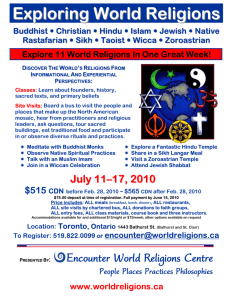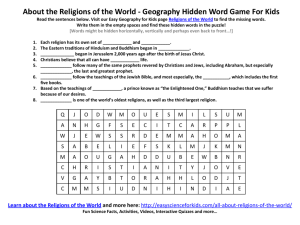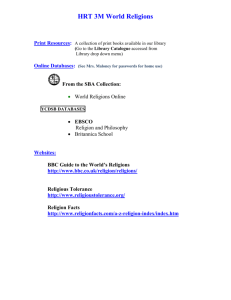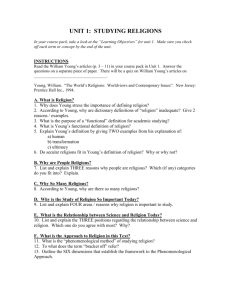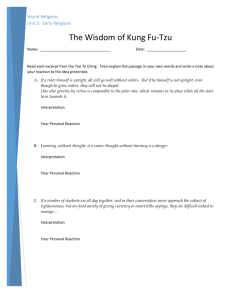Religious Diversity in America: The Emergence of Muslims
advertisement
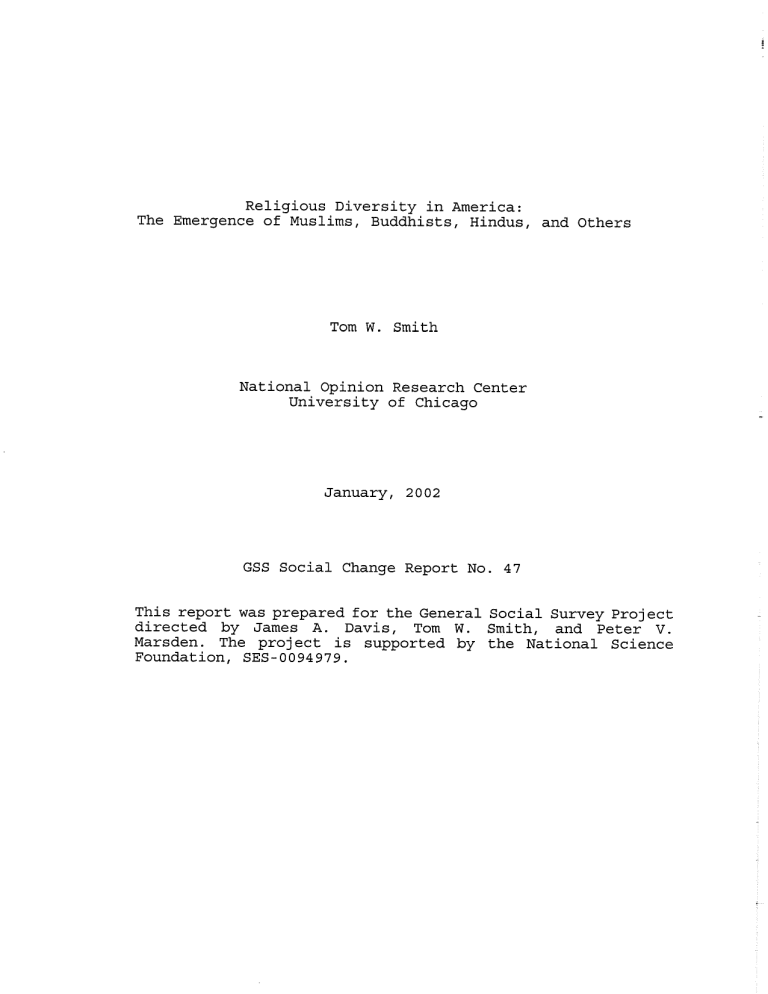
Religious Diversity in America: The Emergence of Muslims, Buddhists, Hindus, and Others Tom W. Smith National Opinion Research Center University of Chicago January, 2002 GSS Social Change Report No. 47 This report was prepared for the General Social Survey Project directed by James A. Davis, Tom W. Smith, and Peter V. Marsden. The project is supported by the National Science Foundation, SES-0094979. Introduction As the Reverend J. Gordon Melton - the country1s champion church counter, once remarked, American society has the I1most diversely religious people on earth." Our tradition of religious pluralism goes deeply into our colonial history. Edwin S. Gaustad noted that even in the early 17th century one found "Huguenots in Charleston, Anglicans in Tidewater Virginia, Catholics in St. Mary's City, Swedish Lutherans along the Delaware, Quakers and Presbyterians further up the river, Dutch Reform in Manhattan, Puritans in New England, Baptists, and Heaven-knows-what-elsein Rhode Island." Early in the history of the American republic, the French aristocrat Talleyrand is reported to have derisively observed that the United States had 32 religions, but only one sauce (Smith, 1990). Since then America has continued to both import foreign and spawn indigenous religions. In recent decades religious diversity has surged forward as the 1965 change in immigrant laws increased the flow of adherents from all the world's faiths and new religions continually formed (Numrich,2000 and 2001; Sherkat, 1999 and 2001; Smith, 1991; Warner 1998a and 1998b). However, the magnitude and nature of America1s religious diversity should not be exaggerated. It has become common for the recent and projected growth of alternative religions and their current prominence to be described as revolutionary and as having transformed American society. Eck (2001) writes of "a new multireligious Americaw in which "the religious landscape of America has changed radically in the past thirty years." The Yearbook of American and Canadian Churches (Linder, 1998) in 1998 switched their basis for estimating non-Judeo-Christian religions and showed --year gains of 6 to 72 fold for Muslims, Hindus, New Religionists, and Sikhs and described these totally artifactual gains as "a vivid example of that accelerating rate of changeu in America's religious profile. The Muslim population is commonly overestimated by a factor of 3-4 and there are assertions that Muslims outnumber the third largest denomination in the US Methodists (Smith, 2001). Impressive as the actual changes in nontraditional religions have been, they can not match these and many related claims about the growth and size of these religions.I This article studies the changing religious composition of America over the last generation. Special attention is given to non-Judeo-Christian religions that until recently had not been a prominent part of America's religious heritage. In particular, the position of Islam, Buddhism, and Hinduism is examined. Trends Non-Judeo-Christian religions make up a small, but growing, share of America's religious mosaic. In 1973-1980 the General Social Surveys (GSS) indicated that they accounted for 0.8% of the adult population. This grew to 1.3% in 1981-1990 and 2.6% in 19902000.' Similarly, the American Religious Identity Surveys (ARIS) put the non-Judeo-Christianreligions at 1.5% in 1990 and 2.4% in 2001 (Kosmin and Lachman, 1993; Kosmin, Mayer, and Keysar, 2001) . 3 Three faiths, Buddhism, Hinduism, and Islam, account for about half of those following other religions. According the GSSs, they totaled 0.4% in 1973-1980, 0.7% in 1981-1990, and 1.1% in 19912000. The ARIS found that they were 0.7% in 1990 and 1.4% in 2001. Likewise, Barna Research placed their share at about 1% in 2001 (Barna, 2001). The remaining non-traditional religions consists of a wide mix of faiths, all so small that detailed delineation is not practical. On the GSSs in 1991-2000 the leading other alternative religions were non-/inter-denominational believers with 0.45% and other Eastern religions (e.g . Jainism, Sikhism, and Taoism), Native American religions, pagans and witches/Wiccans, and those with upersonalnreligions - all about 0.1%. The 2001 ARIS lists the top remaining faiths as pagan, Wiccan, Spiritualist, and Native American. Of the three major non-Judeo-Christian faiths, the GSS finds Muslims growing from 0.2% in 1973-1980 to 0.3% in 1981-1990, to 0.45% in 1991-2000 (Table 1). Unadjusted figures from the ARIS place Muslims at 0.3% in 1990 and 0.5% in 2001. Among the two student samples, the high school seniors in Monitoring the Future (MTF) show no clear trend during the 1990s, but first-year college students in American Freshmen (AF) do indicate a nine-fold rise from 0.1% in the late 1960s to 0.9% in 2000.4 TABLE 1 ABOUT HERE The GSS estimates that Buddhists increased from 0.1% of the adult population in 1973-1980 to 0.3% in 1981-1990 to 0.4% in 19912000 (Table 2). The ARIS finds Buddhists growing from 0.2% in 1990 to 0.5% in 2001. AF finds that Buddhists grew from 0.2% of firstyear college students in 1982 to 1.0% in 2000.' On MTF Buddhists also appear to make up a growing share of high school seniors, but this trend is somewhat obscured by the dropping of California from the coverage starting in 1997.6 TABLE 2 ABOUT HERE For Hindus the GSS indicates a rise from 0.1% of adults in 1973-1980 to 0.1% in 1981-1990 to 0.2% in 1991-2000 (Table 3). The ARIS shows a gain from 0.1% in 1990 to 0.4% in 2001.~ TABLE 3 ABOUT HERE Current Size of Major Non-Judeo-Christian Religions Smith (2001) finds that the best estimate of the contemporary Muslim population with adjustments for non-English speakers is about 0.67%. This comes to about 1.4 million adults or a total population of about 1.9 million.8 There is no consensus on the number of Buddhists in America. As Table 4 indicates, recent estimates range from under 500,000 to over 5,000,000. Estimates are about equally common from a half million to a million all the way up to 4,000,000+. The average estimate is about 2.3 million. TABLE 4 ABOUT HERE Contemporary estimates of the Buddhist share of the adult population from surveys range from 0.2-0.6% (Table 5). Estimates of the total population from the GSS fall in the same range, 0.20.6%.9 However, the samples of high-school seniors and first-year college students both find a higher proportion Buddhist, 1.0%. This may reflect the fact that immigrant populations tend to be younger than the general population. It could also indicate that Buddhism is more popular among the young than among adults of all ages, but that appears unlikely since the parents of first-year college students are more Buddhist than the students themselves. Taking the range of estimates of 0.5- 1.0%, would mean that Buddhists would account for 1.0-2.1 million adults and 1.4-2.8 million in the total population. Given that several general population surveys point towards the lower end of this range and only the student samples towards the higher end, it is likely that the total number of Buddhists is closer to 1.4 million than 2.8 million. TABLE 5 ABOUT HERE In contrast to the Buddhist figures, there is great consensus that the Hindu population is a little over 1,000,000 (Table 4). No estimates are below 500,000 or above 2 million and 74% are in the 1-1.5 million range. Surveys estimate the Hindu adult population at between 0.1% and 0.4% (Table 5) . The GSS estimates of the Hindu share of the total population are between 0.2-0.3%. (No figures are available from either Monitoring the Future or American Freshmen studies.) At 0.3-0.4% Hindus would make up from 627,000 to 837,000 adults and 844,000-1,126,000in the total population. The 2000 Census reports 1,718,778 identifying their race as Asian Indian. Two estimates of the Hindu share among immigrants from India are 45% and 65% (Hofrenning and Chiswick, 1999 and Kurien, 2001) . Using these rates would put the number of ~ s i a n Indian Hindus in the total population between 773,000 and 1,117,000. It is generally believed that the vast majority of Hindus in the US are immigrants from India (rather than converts or immigrants from other countries - see footnote 6 ) , but no numerical estimates appear available.lo Unless the number of non-Asian Indian Hindus are much greater than commonly assumed, the survey estimates of 0.8-1.1 million are very consistent with the Census-adjusted figures of 0.8-1.1 million. Discussion Non-Judeo-Christian faiths are increasing their religious market share. From the 1970s to the present the proportion in these religions grew about 3-4 fold. But even given their rapid rate of growth, their absolute size remains small. The 1998-2000 GSSs find that only 2.7% of adults are followers of non-traditional religions (even counting those with mixed Christian/non-Judeo-Christian faiths, the non-/inter-denominational,and those with upersonalu religions). Likewise, the 2001 ARIS puts other religions at 2.1%. This indicates that non-Judeo-Christian religions are much smaller than frequently cited high-end estimates and have hardly transformed the religious landscape as much as often portrayed. There are several reasons why the size and prominence of these religions have sometimes been exaggerated. First, as Warner (1998a) has noted, these faiths are not only "increasingly n u m e r o ~ s ,but ~ also are I1increasinglyvisible. 1111 New temples, celebrity-converts to Buddhism, turbaned Sikhs, and visits by the Dalai Lama create an impression of prominence beyond the actual size of these groups. Second, elements of the emerging religions have attracted the interest of many more Americans than have been won over as genuine adherents. Tweed (1999), for example, describes "night-stand Buddhists1' who adopt some trappings of the this faith without becoming adherents or even abandoning their existing faith. Similarly, as Ankerberg and Weldon (1991) have noted about Hinduism: In all its forms, Hinduism has influenced tens of million of people in America. By itself Maharishi Mahesh Yogi's Transcendental Meditation, a form of advaita Vedanta Hinduism, has over three million graduates . . . .The New Age movement, with a collective following in the millions, has been powerfully influenced by Hinduism . . . .In addition, literally tens of millions of Americans have taken up Hindu practices, such as yoga, meditation, developing altered states of consciousness, and various other occultic seeking Hindu llenlightenment,ll practices. America has always been a religiously diverse nation and recent changes in immigration patterns as well as indigenous religious developments have increased that diversity. While Americans still overwhelmingly adhere to their traditional faiths, the United States is home to all of the world's religions and nonJudeo-Christian religions make up a small, but growing, share of America's religious mosaic. 1. Nor is the rise in adherents of alternative religions the largest religious change occurring in America. Changes that are as important and larger in size include the increase in those without any religious affiliation (Hout and Fischer, 2001) and the rising proportion of Protestants who are Fundamentalists (Hout, Greeley, and Wilde, 2. 2001). On the GSSs see Davis, Smith, and Marsden, Sherkat, 1999 2001. Also see for similar figures. 3. The GSS and ARIS differ in various ways in what constitutes alternative religions. For example, ARIS includes unitarian/ Universalist and Spiritualist under this group, but puts all nondenominational in the Christian category. The GSS counts the Unitarians/Universalists and Spiritualists as Protestants and puts those who said non/inter-denominational, but who did not identify themselves as Catholic, Protestant, or Christian, in the alternative category. 4. The AF figures for 2 0 0 0 are suspect however since they show such a large, one-year increase since Smith, 5. 1999. On Muslims in America see 2001. The increase among students from 1999-2000 1998-2000 and for parents for is rather steep and probably exaggerates the rate of short-term change. 6. On Buddhists in America see Baumann, 1 9 9 7 ; Coleman, 2 0 0 1 ; Eck, 2001; Miller, 1995; Warner and Wittner, Numrich, 1998. 2000; Prebish and Tanka, 1998; and 7. On Hindus in America see Ankerberg and Weldon, 1991; Eck, 2001; Kurien, 2001; Miller, 1995; Rajagopal, 2000; and Warner and Witttner, 1998. 8. Smith (2001) discusses estimates of the Muslim population, so they are not covered in detail in this report. 9. GSS estimates for the total population assigns respondent's religion to all household members. 10. Other countries with majority or near majority Hindu populations are relatively small (Ash, 1997 and Barrett, Kurian, and Johnson, 2001) , most contribute a small number of immigrants to the US (INS, 1999), and their immigrants are not separately distinguished on the Census race item. For 1987-1997 immigrants from Indian constituted 99.2% of all immigrants from majority Hindu countries and 76.5% of all immigrants from countries that were a third or more Hindu (INS, 1999) . 11. On the ~visibility~ factor see also Eck, 2001, p. 1. References Ankerberg, John and Weldon, John. 1991. The facts on Hinduism. Eugene, OR: Harvest House. Arriaga, Alexandra. 1997. Implementation of the Declaration on the Elimination of all Forms of Intolerance and Discrimination Based on Religion or Belief. Item 19, U.S. Department of State, March 24, 1997 at www.state.gov Ash, Russell. 1997. The top 10 of everything. New York: DK Publishing. Barna Research Online. 2001. Beliefs: General religions. at www. barna .org Barrett, David B.; Kurian, George T.; and Johnson, Todd M. 2001. World Christian encyclopedia: A comparative survey of churches and reliqions in the modern world. New York: Oxford university Press. Baumann, Martin. 1997. The dharma has come west: A survey of recent studies and sources. Journal of Buddhist Ethics, 4: 198. Broadwater, Gae. 2000. Celebrating a diversity of holidays. Cooperative Extension Service, University of Kentucky, at http://web. extension.uiuc.edu Coleman, James William. 2001. The new ~uddhism: he western transformation of an ancient tradition. New York: Oxford University Press. Davis, James A.; Smith, Tom W.; and Marsden, Peter V. 2001. General Social Surveys, 1972-2000: Cumulative Codebook. chicago: NORC. Eck, Diana L. 2001. A new reliqious America. San Francisco: Harper. Encyclopaedia Britannica Book of the Year, 1997-2001. Engley, Hollis. 1999. Searching for God in all the new places. USA Today, May 27, 1999 at www.usatoday.com Facts about Hinduism. 1997. Smithsonian Institute at www.asia.si.edu George, David. 1995. Politics, religion hard to separate despite constitutional division. December 18, 1995 at www6.cnn.com Halverson, Dean C. and Bhattacharya, Natun. 1999. Effective evangelism witnessing to Hindus. Statement DH-122 at www.equip.org Hinduism in America. 2001. Vishwa Dharma Prasaar Yaatra 2001 at www.hindunet.org Hindus in America. 2001. Reliqion and Ethics Newsweekly August 17. Hofrenning, Stella Koutroumanes and Chiswick, Barry R. 1999. A method for proxying a respondent's religious background: An application to school choice decisions. Journal of Human Resources 34: 193-207. Hout, Michael and Fischer, Claude S. 2001. Explaining the rise of Americans with no religious preference: Politics and generations. Survey Research Center, University of California, Berkeley. Hout, Michael; Greeley, Andrew; and Wilde, Melissa J. 2001. The demographic imperative in religious change in the United States. Survey Research Center, University of California, Berkeley. Institute for Social Research. 1991-2001. Monitorins the Future [1990-20001.Ann Arbor: ISR. Kosmin, Barry A. and Lachman, Seymour P. 1993. One nation under God: Relision in contemporary American societv. New York: Harmony Books. Kosmin, Barry A., Mayer, Egon; and Keysar, Ariela. 2001. American religious identification survey. City University of New York. Kurien, Prema. 2001. Religion, ethnicity, and politics: Hindu and Muslim Indian immigrants in the United States. Ethnic and Racial Studies 24: 263-293. Kurtz, Paul. 2001. America the beautiful, open to all. Free Inquirv Maqazine, 21. Latest Religious Preference for U.S. 2000. Emerqins Trends 22: (March): 2. Latest (2000) Religious Preference for U.S . Emersins Trends 23 : (Jan.): 4. Linder, Eileen W. 1997-2001. Yearbook of American and Canadian Churches, [1997-20011. Nashville: Abingdon Press. Long, Justin D., North America: ~ecline& fall of world religions, 1900-2025. at http://gem-werc.org Miller, Timothy, ed. Albany: SUNY. 1995. America's alternative religions. Nattier, Jan. 1998. Whip is a Buddhist? Changing the landscape of Buddhist America, in Prebish, Charles S. and Tanka, Kenneth K, eds., The faces of Buddhism in America. Berkeley: University of California Press. Nattier, Jan. 1999. Why Buddhism, Why now? And Why in America? World Tibet Network News. December 27, 1999 at www.tibet.ca 95% of Americans are not familiar with Hindu culture. 2001. Vaishnava News, Sept. 7, 2001 at www.vnn.org Non-Christian religious adherents in the United States. 1998. at www.infoplease.com Numrich, Paul David. 2000. How the swans came to Lake Michigan: The social organization of Buddhist Chicago. Journal for the Scientific Studv of Relision 39: 189-203. Numrich, Paul D. 2001. The numbers question: Or, how many immigrants does it take for a research initiative on religion? unpublished report. Ostling, Richard N. 1999. America's ever-changing religious landscape. Brookinss Review (Spring), 10-13. Pluralism Project, Statistics by tradition. www.pluralism.org/ resources/tradition.php Prebish, Charles S. and Tanka, Kenneth K, eds. 1998. The faces of Buddhism in America. Berkeley: University of California Press. Prichard, James. 2001. Hindus gather in Michigan. Detroit News, June 14, 2001 at www.detnews.com Prothero, Stephen. 2001. Boomer Buddhism. February 26, 2001, at www.salon.com Queen, Christopher S. 1999. Introduction in American Buddhism: Methods and findinss in recent scholars hi^, edited by Duncan Ryuken Williams and Christopher S. Queen. Richmond, England: Curzon Press. Rajagopal, Arvind. 2000. Hindu nationalism in the US: Changing configurations of political practice. Ethnic and Racial Studies 23 (May): 467-496. Religious News Service. 2001. Christianity still world's largest religion. January 18, 2001 at www.beliefnet.com Robinson, B.A. 2001a. Buddhism. religioustolerance.org July 8, 2001 at www. Robinson, B.A. 2001b. Religious Makeup of the United States at www.religioustolerance.org Sax, L.J., et al. 2000. The American freshman: National norms for Fall 2000. Los Angeles: Higher Education Research Institute. Sherkat, Darren E. 1999. Tracking the 'other1: Dynamics and composition of 'other1 religion in the General Social Survev. 1973-1996. Journal for the Scientific Study of Relision, 38: 551-560. 4 Sherkat, Darren E. 2001. Tracking the restructuring of American religion: Religious affiliation and patterns of religious mobility, 1973-1998. Social Forces, 79 (June): 1459-1493. Smith, Tom W. 1990. Classifying Protestant denominations. ~eviewof Relisious Research, 31: 225-245. Smith, Tom W. 1991. Counting flocks and lost sheep: Trends in religious preference since World War 11. GSS Social Change Report No. 26. Chicago: NORC. Smith, Tom W. 2001. Estimating the Muslim population in the United States. report prepared for the American Jewish Committee. Tweed, Thomas A. 1999. Night-stand Buddhism and other creatures: Sympathizers, adherents, and the study of religion in American Buddhism: Methods and findinss in recent scholars hi^, edited by Duncan Ryuken Williams and Christopher S. Queen. Richmond, England: Curzon Press. United States Hindus relatively unknown. 2001. Religious News Service, August 25, 2001 at www.amarillonet.com United States of America. 2000. ebooks/whsmithonline.co.uk U.S. Immigration and Naturalization Service. 1999. Statistical yearbook of the Immisration and naturalization Service, 1997. Washington, DC: GPO. Warner, R. Stephen. 1998a. Approaching religious diversity: Barriers, byways, and beginnings. Sociolosv of Relision 59: 193-215. Warner, R. Stephen. 1998b. Religion and migration in the United States. Social Com~ass45: 123-134. Warner, R. Stephen and Wittner, Judith G., eds . 1998. Gatherinss in Dias~ora:Reliqious communities and the new immisration. Philadelphia: Temple University Press. Woo, Elaine. 2000. U.S. Buddhism Leader Havanpola Ratabasara Dies. Los Anseles Times at www.kusala.org World Almanac and Book of Facts, 1998-2000. World Religions. 2001. at www.namb.net Table 1 Trends in Muslim Religious Identity Monitoring the Future: High School Seniors *California omitted starting in 1997 American Freshmen: Students Mothers Fathers Table 1 (continued) General Social Surveys American Religious Identity Survey Source: ISR, 1991-2000; Sax, et al., 2001; Davis, Smith, and Marsden, 2001; Kosmin and Lachman, 1993; Kosmin, Mayer, and Keysar, 2001 Table 2 Trends in Buddhist Religious Identity Monitoring the Future: High School Seniors *California omitted starting in 1997 American Freshmen: Students Mothers American Religious Identification Survey General Social Surveys Fathers Table 2 (continued) Source: Davis, Smith, and Marsden, 2001; Kosmin and Lachman, 1993; Kosmin, Mayer, and Keysar, 2001; Sax, et al., 2001; ISR, 1991-2000 Table 3 Trends in Hindu Religious Identification General Social Survey American Religious Identity Survey Source: Davis, Smith, and Marsden, 2001; Kosmin and Lachman, 1993; Kosmin, Mayer, and Keysar, 2001 Table 4 Recent Estimates of the Buddhist and Hindu Population in the US Population Buddhist Hindu Less than 500,000 500,000-999,999 1,000,000-1,499,999 1,500,000-1,999,999 2,000,000-2,999,999 3,000,000-3,999, 999 4,000,000-4,999, 999 5,000,000+ Average 2,300,000 1,110,000 Source: "95%...,11 2001; Ash, 1997; Robinson, 2001a and 2001b, "United States. . . , l1 2000; "Hinduism.. . , 2001; "World Religion. . . , 2001; Halverson and Bhattacharya, 1999; Arriaga, 1997; "United States Hindus . . . , " 2001; "Hindus...," 2001; Prichard, 2001; llFacts...,ll 1997; Ostling, 1999; Long, n.d.; Broadwater, 2000; Kurtz, 2001; George, 1995; Engley, 1999; Pluralism, n.d.; World Almanac, 2000; Encvclo~aedia Britannica, 2000; Linden, 1996; Prothero, 2001; Nattier, 1998 and 1999; Woo, 2000; Queen, 1999; Baumann, 1997; Barrett, Kurian, and Johnson, 2001; "NanChristians ...," 1998. Table 5 Current Survey Estimates of Buddhists and Hindus Buddhists Hindus NL NL NL 0.2 less than 1% less than 1% 0.1 NL General Social Survey Adults : Total Population: American Religious ~dentificationSurvey 2001 Gallup American National Election Studies American Freshman First-Year College Students NL=Not listed he first number is based on all respondents and second is among those who were asked their religion. Only those who attended services or who said they were members of a church were asked their religion. Source: ANES, 1996 and 2000; Davis, Smith, and Marsden, 2001; Sax et al., 2001; "Latest... , 2000 and 2001; Kosmin and Lachman, 1993; Kosmin, Mayer, and Keysar, 2001

